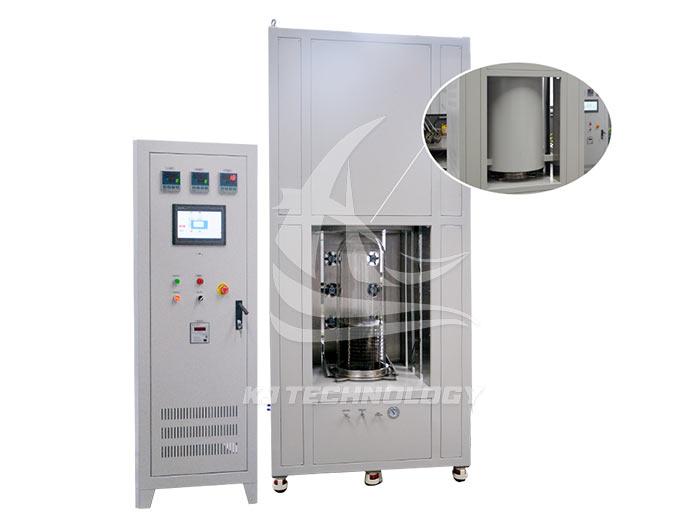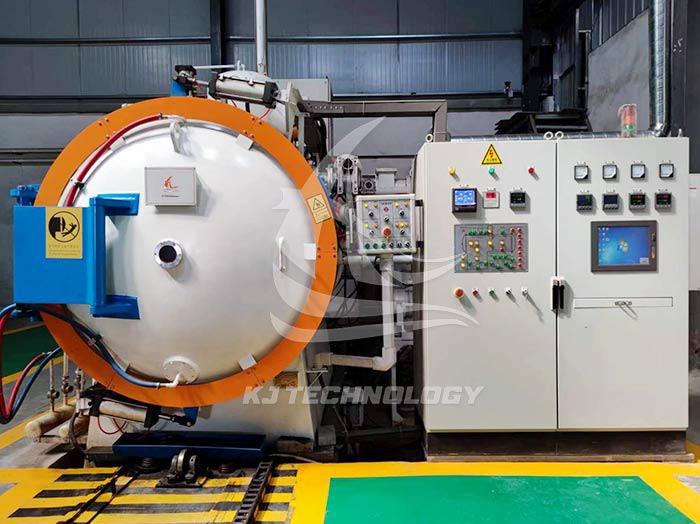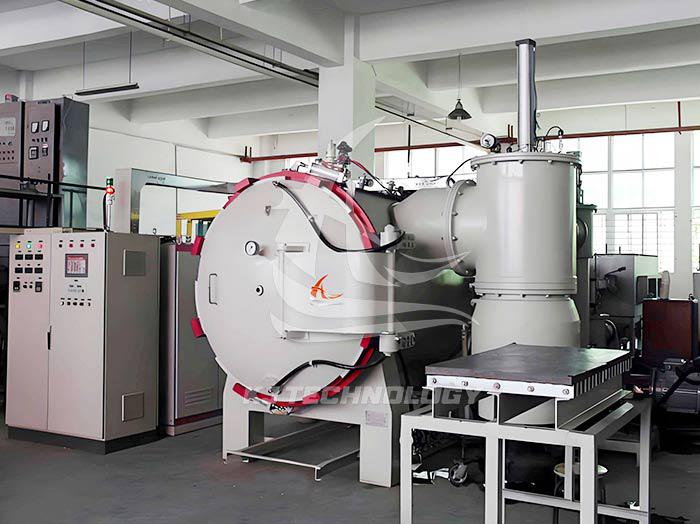What are the advantages of electric heating vacuum heat treatment furnace?
 08-14-2025 Author: KJ technology
08-14-2025 Author: KJ technology
The electric heating vacuum heat treatment furnace has shown significant advantages in the field of material heat treatment by combining vacuum environment and electric heating technology, especially suitable for the processing of high-precision and high-performance materials. The following is a detailed analysis of its core advantages:
1. Non oxidative decarburization ensures material performance
Principle: A vacuum environment (pressure ≤ 10 ⁻ ³ Pa) isolates oxidizing gases such as oxygen and water vapor to prevent material surfaces from reacting with oxygen.
effect:
Preventing the formation of oxide film: Heating stainless steel in an air furnace will form an oxide scale with a thickness of 0.1-0.3mm, and the surface will be smooth and new after vacuum treatment, without the need for subsequent acid washing or polishing.
Inhibition of decarburization layer: When high carbon steel (such as T10A tool steel) is heated to 850 ℃ in a vacuum furnace, the carbon content loss is ≤ 0.05%, while the decarburization layer depth in an air furnace can reach 0.5mm, significantly reducing the material hardness.
Typical applications: Aircraft engine blades, mold steel, and other parts that require extremely high surface quality.
2. Excellent surface quality, reducing subsequent processing
Cleanliness improvement: The vacuum environment promotes the decomposition and evaporation of impurities such as grease and emulsion on the surface of the workpiece. After being extracted by a vacuum pump, the surface residue is reduced by more than 90%.
Roughness optimization: After processing, the surface roughness of the workpiece can be reduced to below Ra0.2 μ m, approaching a mirror effect and meeting high-precision requirements for semiconductors, optical devices, and other applications.
Cost savings: Taking automotive gears as an example, after vacuum treatment, they can be directly assembled, eliminating the grinding process and reducing individual unit costs by 15%.
3. Precise deformation control to improve product yield
Thermal stress reduction: The radiation heating method reduces the thermal temperature difference inside the workpiece by ≤ 5 ℃, resulting in a 60% -80% reduction in thermal stress compared to traditional processes.
Deformation control:
Thin walled processing: 304 stainless steel sheet with a thickness of 1mm is quenched in a vacuum furnace, with a flatness deviation of ≤ 0.05mm, while the oil quenching deformation reaches 0.3mm.
Complex shaped parts: After vacuum treatment, the dimensional shrinkage rate of the aviation titanium alloy frame remains stable at 0.1% -0.2%, meeting the assembly tolerance requirements.
4. Energy saving and environmentally friendly, in line with the trend of green manufacturing
Thermal efficiency improvement: The electric heating system has a thermal efficiency of over 95%, which is 40% more energy-efficient than gas furnaces and 25% more energy-efficient than resistance furnaces.
Emission reduction:
No exhaust gas: The vacuum environment eliminates the emission of pollutants such as NOx and SO ₂, meeting the requirements of the EU RoHS directive.
No wastewater: No need for quenching oil cooling, avoiding the cost of treating oily wastewater.
Typical data: Processing 1 ton of workpiece, a vacuum furnace reduces CO ₂ emissions by 3.2 tons compared to an air furnace, equivalent to the environmental benefits of planting 178 trees.
5. High process flexibility to adapt to diverse needs
Wide temperature range: It can achieve precise temperature control from 200 ℃ (stress relief annealing) to 1600 ℃ (high-temperature sintering) to meet the processing needs of different materials.
Diverse atmosphere control:
Vacuum brazing: Achieve non oxidative connection between aluminum alloy and stainless steel under a vacuum degree of 10 ⁻ Pa, with a weld strength of over 90% of the base material.
Local inflation: When dealing with active metals such as titanium and zirconium, argon gas can be filled for protection to prevent hydrogen absorption and embrittlement.
Composite process integration: Some high-end vacuum furnaces integrate functions such as plasma cleaning and ion nitriding, achieving "one furnace for multiple uses".
6. Significant improvement in material properties
Improvement of organizational uniformity: The vacuum environment promotes the diffusion of alloy elements and reduces segregation phenomena. For example, after vacuum treatment, GH4169 high-temperature alloy has a more uniform distribution of γ 'phase and a 20% increase in creep resistance.
Mechanical performance optimization:
Hardness improvement: After vacuum quenching, the hardness of M2 high-speed steel reaches 63-65HRC, which is 2-3HRC higher than air quenching.
Enhanced toughness: After vacuum tempering, the impact toughness of 42CrMo steel increased from 25J/cm ² to 38J/cm ², and the fracture toughness increased by 50%.
7. High level of automation and intelligence
Accurate temperature control: using PID algorithm and infrared thermometer, temperature fluctuation ≤ ± 1 ℃, meeting the requirements of aerospace material processing.
Data traceability: Built in industrial computer records process parameters (temperature, vacuum degree, time) for each furnace, supporting ISO9001 quality system certification.
Remote monitoring: Real time monitoring of device status is achieved through IoT technology, with a fault warning accuracy rate of 98%, reducing unplanned downtime.
8. Wide range of applicable materials
Metallic materials:
High temperature alloys such as Inconel 718 and GH3536 are used for turbine discs in aircraft engines.
Titanium alloys, such as TC4 and TA15, are used for biomedical implants.
Precision alloy: such as 1J50 soft magnetic alloy, used for electronic components.
Non metallic materials:
Ceramics, such as Al ₂ O3 and ZrO ₂, are used for tool coating.
Composite materials: such as C/C composite materials, used for spacecraft thermal protection systems.
summarize
The electric heating vacuum heat treatment furnace has become a key equipment in the high-end manufacturing field due to its characteristics of no oxidation, low deformation, and high precision. Its advantages are not only reflected in the improvement of product quality and cost savings, but also in line with the industrial upgrading direction of energy conservation, emission reduction, and intelligent manufacturing. With the development of materials science and industrial technology, vacuum heat treatment technology will evolve towards higher temperatures, more complex atmosphere control, and greater intelligence, continuously driving the manufacturing industry towards high-end development.








